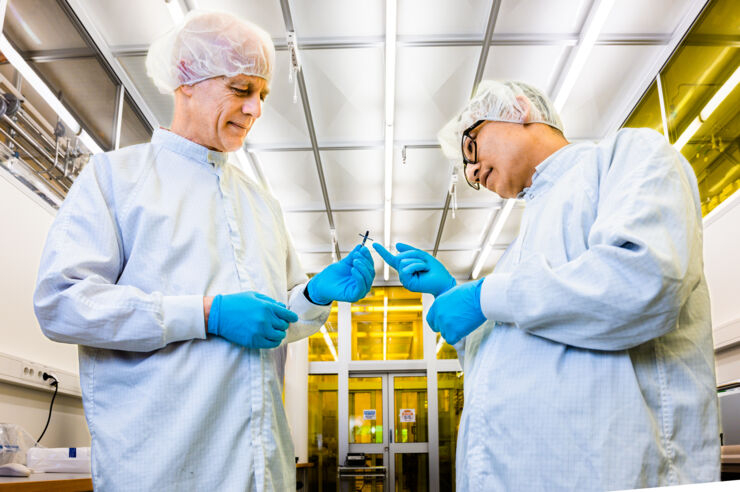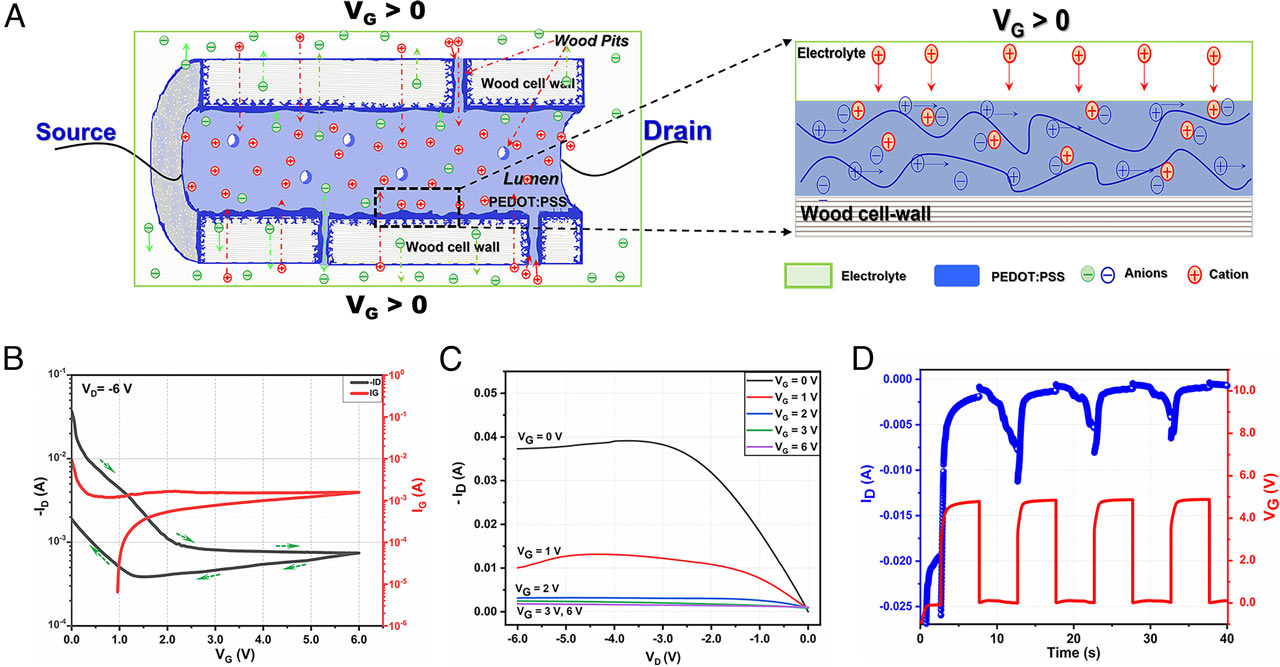World's First Wood Transistor Chops Out at 1 Hz
It can't run Doom yet, but it's made from renewable materials.

The idea of silicon transistor and processors is so . . . 2022. Researchers in Sweden have designed and tested the first wooden transistors. Teams at Linköping University in Norrköping, and the Royal Institute of Technology in Stockholm, have published a paper titled Electrical current modulation in wood electrochemical transistors, which discusses the creation, capabilities, and potential of the wood electrochemical transistor (WECT) they have recently developed.
This WECT could pave the way for wood-based electronics that are more sustainable and biodegradable. Moreover, wood electronics could deliver the electronic control of living plants.
Not Nanometers, But Centimeters
Regular readers will be very familiar with the latest advances in silicon transistor technology. Almost daily our headlines relay advances from Intel, Samsung and TSMC, battling to create leading edge processes, with transistors measured in nanometers, and running at multi-gigahertz speeds. Brace yourself now though, as the WECT designed and tested by the Swedish researchers measured 3cm across and had a switching frequency of under one hertz.
Not every electronic device needs the fastest speeds and smallest transistors. Certainly, the WECT as described is rather big and doesn’t like to be hurried. “We've come up with an unprecedented principle,” Isak Engquist, senior associate professor at the Laboratory for Organic Electronics at Linköping University stated in a university press release. “Yes, the wood transistor is slow and bulky, but it does work, and has huge development potential.”

How Wood Turned Into a Transistor
To describe how wood can be used to make a transistor, let us start by looking at conventional transistors that are widely used in electronic devices. Field effect transistors are a key building block of modern electronics and most commonly fabricated from semiconductors like silicon or germanium.
The inherent nature of these elements allow a transistor to act as an amplifier or switch when a voltage or current is applied to its terminals. Since the first FETs were produced in the mid-20th Century, R&D has been continuous in miniaturizing them and coaxing them to run at extraordinary frequencies.



To create the WECT, the researchers required conductive wood (CW). This is made by removing the lignin from wood via a chemical solvent process. Subsequently the channels where lignin were present are replaced with a mixed electron-ion conducting polymer. In this project the chosen wood was Balsa (for its desirable inner channel structure) and conductive polymer PEDOT:PSS. To construct the WECT, three pieces of CW were used: one piece as the central transistor channel, and one each as top and bottom gate.
Get Tom's Hardware's best news and in-depth reviews, straight to your inbox.
The WECT transistor is remarkable, even though it doesn’t have the kinds of specs we usually discuss on Tom’s Hardware. Rather than being an end in itself, the researchers say they provided evidence of the wood transistor’s possibilities, and hope that they will inspire future work and applications.

Mark Tyson is a news editor at Tom's Hardware. He enjoys covering the full breadth of PC tech; from business and semiconductor design to products approaching the edge of reason.
-
Leptir What "future work and applications"?! This is totally useless. Clearly some people have entirely too much free time and resources at their disposal.Reply -
thisisaname It may have started out has wood just not sure it can be called wood once the lignin was removed leaving only long cellulose fibres. The "wood" was just there to give shape to the "a conductive plastic, or polymer, called PEDOT : PSS,",Reply
Also not sure how environmental it all is either. -
bit_user Reply
That isn't remotely true and suggests you're seriously lacking imagination and creativity. It will likely have long-term applications in farming and forestry, for embedding some monitoring & control circuits directly into the plants, themselves.Leptir said:What "future work and applications"?! This is totally useless. Clearly some people have entirely too much free time and resources at their disposal.
As for the size and speed, perhaps they could get onto a Moore's Law-type improvement curve. The real breakthrough is going to be when someone figures out how to grow these, and use them to genetically engineer circuits directly into plants. -
LabRat 891 ReplyLeptir said:What "future work and applications"?! This is totally useless. Clearly some people have entirely too much free time and resources at their disposal.
Commentary like this reminds me of how the very principals involved in an electromagnetic motor, were once taught as "useless, and purely academic".
At the least, this "seemingly-useless" invention, demonstrates that 'just about anything can be turned into a transistor'. The principles quantified here, may have far-reaching use, including medical devices and power circuitry.
(Not to mention, it looks like other than specialized materials used, this is an experiment you could almost 'do at home'.
So, this may have DIY/homebrew applications.) -
bit_user Reply
If nature figured out how to grow bones and shells, then I trust there's a way to coerce plants to do something equivalent to what they did, here.thisisaname said:It may have started out has wood just not sure it can be called wood once the lignin was removed leaving only long cellulose fibres. The "wood" was just there to give shape to the "a conductive plastic, or polymer, called PEDOT:pSS,",
Also not sure how environmental it all is either. -
Giroro Silicon is more sustainable than woodReply
Once I saw a magazine make an "OLED" by shoving a pickle on an arc welder. -
bit_user Reply
Exactly where did anyone suggest they would ever replace silicon-based electronics?Giroro said:Silicon is more sustainable than wood
I think you'd only use these in contexts where silicon has some inherent disadvantage. -
Alvar "Miles" Udell Think of all the electronics out there that don't need fast processing, things like pregnancy test and glucose meters, many of which are disposable. Things like wood-based electronics would not only make them more sustainable, but far more accessible to emerging markets. They could also lead to the development of inexpensive, disposable biodegradable devices which could have applications in food safety and many other fields.Reply